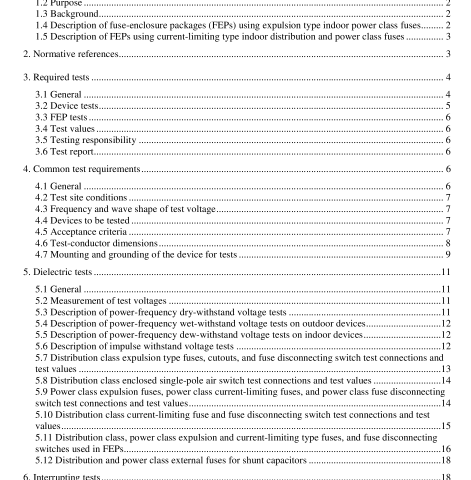IEEE C37.41-2008 pdf download.IEEE Standard Design Tests for High-Voltage (>1000 V) Fuses, Fuse and Disconnecting Cutouts, Distribution Enclosed Single-Pole Air Switches, Fuse Disconnecting Switches, and Fuse Links and Accessories Used with These Devices
This standard specifies design test requirements for high-voltage (above 1000 V) fuses, distribution enclosed single-pole air switches, disconnecting cutouts, fuse disconnecting switches, and accessories for use on ac ower and distribution systems. Devices with rated maximum voltages to 170 kV are covered.
The devices to which this standard applies are as follows:
a) Distribution and power class expulsion type fuses
b) Distribution and power class current-limiting type fuses
c) Distribution and power class fuse disconnecting switches
d) Item a) through item c) used in fuse enclosure packages
e) Fuse supports of the type intended for use with distribution and power class fuses, and fuse disconnecting switches
f) Fuse and disconnecting cutouts
g) Disconnecting devices created by the use of a removable switch blade in a distribution or power class fuse support
h) Distribution class enclosed single-pole air switches
i) Distribution class and power class expulsion, current-limiting, and combination types of external capacitor fuses used with a capacitor unit, groups of units, or capacitor banks
j) Backup current-limiting fuses (“motor-starter fuses”) used in conjunction with high-voltage Class E2 motor starters (see ANSI/UL 347-2000 [B1]) 1
k) Fuse links when used exclusively with distribution class and power class fuses, and distribution class and power class fuse disconnecting switches
l) Item a) through item d) and item f) through item i) having integral load-break means
1.2 Purpose
This standard specifies the minimum testing requirements for fuses and related devices. Such standardization is needed to ensure uniform minimum product testing for devices within the document scope. Test areas covered are based on historical experience.
1.3 Background The distribution and power class expulsion type fuses listed in 1.1 are similar to those now covered in IEC 60282-2. 2 The distribution class expulsion type fuses are similar to the class “A” fuses covered in the document, and the power class fuses are similar to their class “B” fuses. Some of the current-limiting type fuses listed in 1.1 are similar to those now covered in IEC 60282-1. However, significant differences exist in the testing requirements of IEC and IEEE/ANSI. IEEE fuse standards primarily reflect applications common in North America and in countries that use electrical systems designed using similar principles. IEC standards tend to rely heavily on practices common in Europe. Since IEC testing differences include testing at different voltages for the same fuse rated voltage, and different or no testing for fuses intended for use in a surrounding temperature above 40 °C, the user is advised to exercise extreme caution if devices specified and tested per IEC standards are compared with those specified and tested per IEEE/ANSI standards. The differences in test requirements may result in devices tested to IEC not being suitable for applications where devices tested to IEEE/ANSI standards are required, or vice versa. In the headings and the text of this document, there are some areas where information is included in brackets [ ].
The information in the brackets is a term used in IEC standards that may be similar to the term used in this document, a term that is common in some parts of the world, or a term that has been used previously in IEEE or ANSI standards. Caution is again advised when making comparisons.
1.4 Description of fuse-enclosure packages (FEPs) using expulsion type indoor power class fuses Type 1E: A fuse mounted in an enclosure with relatively free air circulation within the enclosure (e.g., an expulsion fuse mounted in an enclosure or vault).
Type 2E: A fuse mounted in a container with restricted air flow surrounding the fuse, but with relatively free air circulation within the enclosure on the outside of the container (e.g., an expulsion fuse in an enclosure with insulating barriers that form a container that restricts the air flow).
Type 3E: A fuse directly immersed in liquid and mounted in an enclosure with relatively free liquid circulating around the fuse (e.g., an expulsion fuse in a liquid-filled switchgear enclosure).IEEE C37.41 pdf download.IEEE C37.41-2008 pdf download
IEEE C37.41-2008 pdf download

Leave a Reply